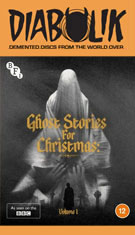
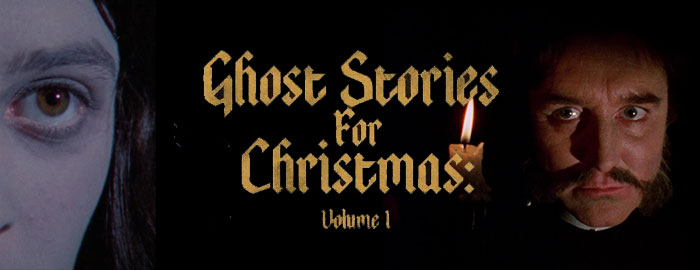
WHISTLE AND I'LL COME TO YOU
B&W, 1968, 41 mins 52 secs..
Starring Michael Hordern, Ambrose Coghill, George Woodbridge
THE STALLS OF BARCHESTER
Color, 1971, 45m.
Directed by Lawrence Gordon Clark
Starring Robert Hardy, Clive Swift, Thelma Barlow, Will Leighton
A WARNING TO THE CURIOUS
Color, 1972, 50m.
Directed by Lawrence Gordon Clark
Starring Peter Vaughan, Clive Swift, Julian Herington, John Kearney
LOST HEARTS
Color, 1973, 35m.
Directed by Lawrence Gordon Clark
Starring Simon Gipps-Kent, Joseph O'Conor, Susan Richards, James Mellor, Roger Milner
WHISTLE AND I'LL COME TO YOU
Color, 2010,
52m.
Directed by Andy DeEmmony
Starring John Hurt, Gemma Jones, Lesley Sharp
BFI (Blu-ray & DVD) (UK RB/R2 HD/PAL), Shock (Australia R0 PAL)
A longstanding TV tradition in the U.K. on and off over the years that continues to this day, A Ghost Story for Christmas has become synonymous with the season as the BBC presents disquieting, suggestive tales of the supernatural. The bulk of the tales have been adaptations of M.R. James, though other authors have crept in over the years and the aesthetic has been woven into many other productions (especially The League of Gentlemen and Inside No. 9). For many years, the classic episodes were impossible to see in decent quality and existed mainly as bootlegs recorded off the air, but the BFI has since worked with the BBC to present multiple editions of these classics with each one improving substantially on the last. Released in 2022, Ghost Stories for Christmas: Volume 1 presents the first four of these chilling milestones along with a modern-day remake to round out the set.
Before the 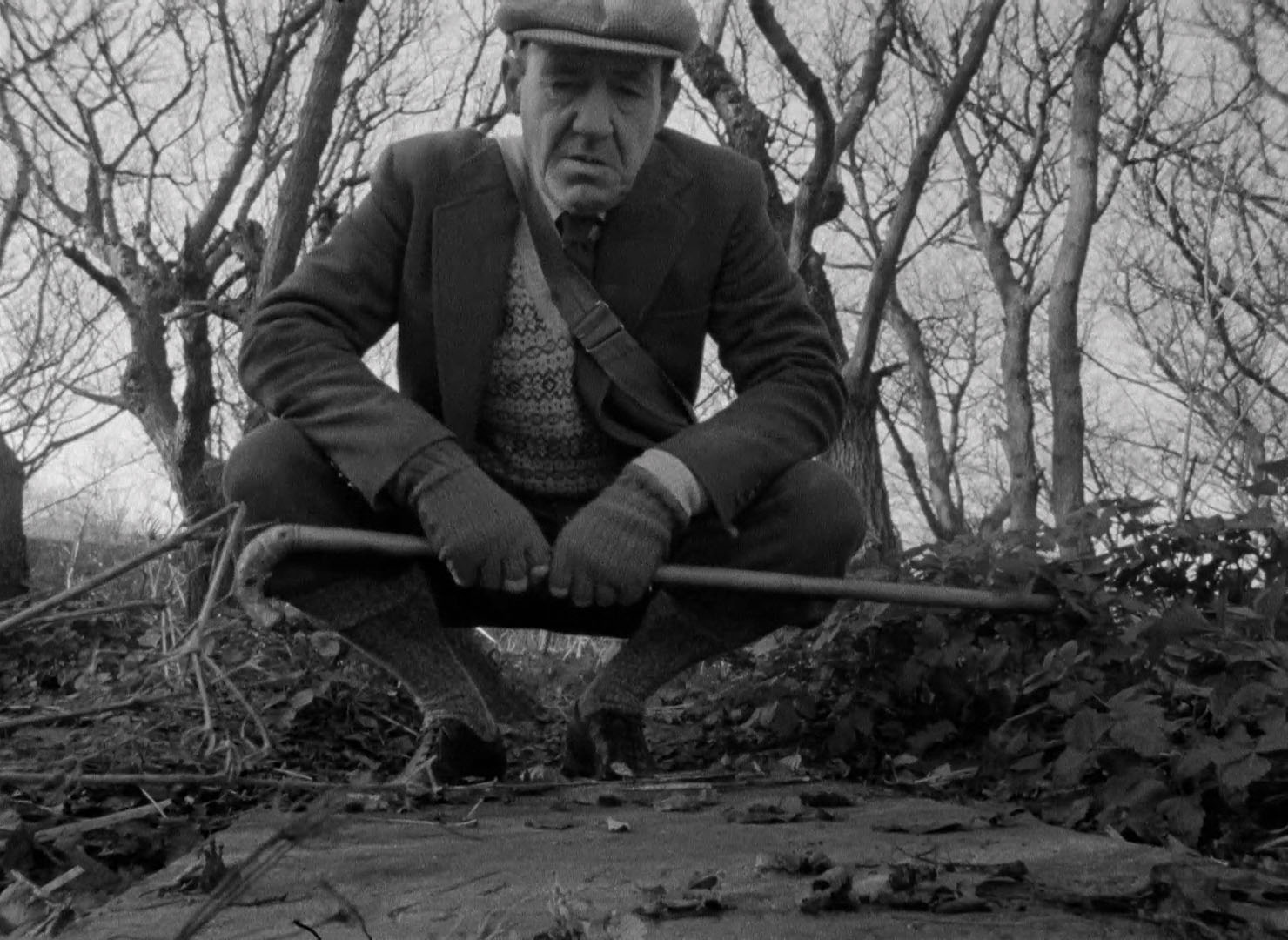 BBC began a '70s tradition of commemorating each Christmas with a spooky English ghost story for television, viewers had already gotten a taste of masterful gh
BBC began a '70s tradition of commemorating each Christmas with a spooky English ghost story for television, viewers had already gotten a taste of masterful gh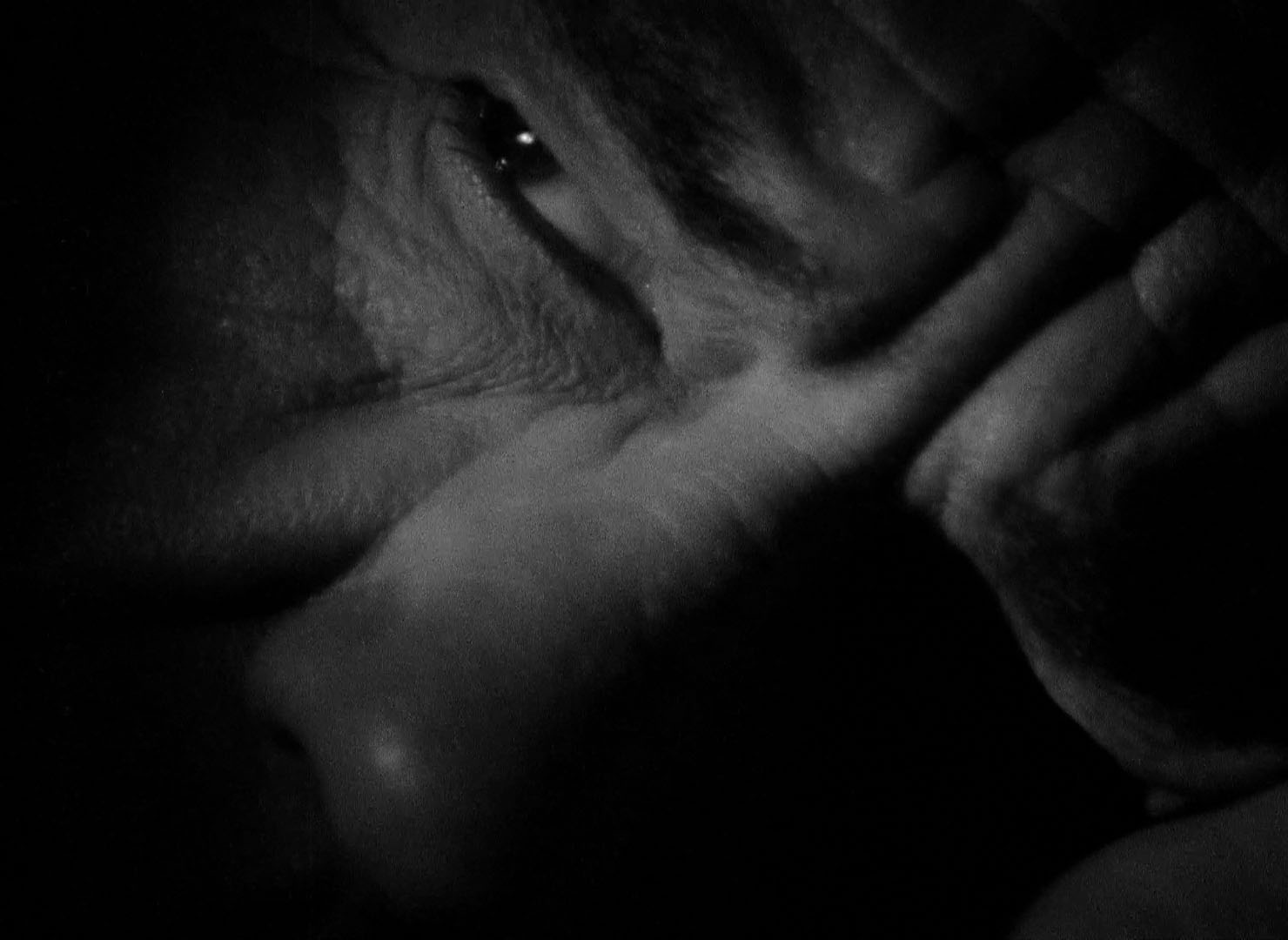 ost story author M.R. James courtesy of one of the most eerie, memorable chillers made for the small screen courtesy of Whistle and I'll Come to You (adapted from the story "Oh, Whistle, and I'll Come to You, My Lad"). The most famous episode of the TV series Omnibus, it stars the great Michael Hordern (Theatre of Blood) as self-impressed Professor Parkins, who heads off to a Norfolk beach for some R&R and has no problem using his imposing deductive skills to dismiss any suggestion of the uncanny. One day he comes across an ancient whistle buried in the sand while researching a Templar Knights cemetery and decides to test it out... but afterwards he's plagued by the feeling that something is following him. And it isn't very nice.
ost story author M.R. James courtesy of one of the most eerie, memorable chillers made for the small screen courtesy of Whistle and I'll Come to You (adapted from the story "Oh, Whistle, and I'll Come to You, My Lad"). The most famous episode of the TV series Omnibus, it stars the great Michael Hordern (Theatre of Blood) as self-impressed Professor Parkins, who heads off to a Norfolk beach for some R&R and has no problem using his imposing deductive skills to dismiss any suggestion of the uncanny. One day he comes across an ancient whistle buried in the sand while researching a Templar Knights cemetery and decides to test it out... but afterwards he's plagued by the feeling that something is following him. And it isn't very nice.
Considering its reputation, this adaptation actually shows very little in the way of actual horrific content -- but the glimpses it provides are indelible enough, entirely confined to the third act. Hordern's performance is one of his best and demonstrates how well he could carry a project of his own (which happened far too rarely), and the direction by Jonathan Miller (who also helmed the memorably creepy and bizarre '66 version of Alice in Wonderland) hits all the right notes.
In 2010, the BBC commissioned another version of the same short story, albeit with so many changes fans may not even recognize it at first. This time John Hurt takes on the leading role and is now recovering from the trauma of putting his mentally incapacitated wife (Jones) in a nursing home. His time at the beach is disrupted when he finds a ring (no whistle this time -- go figure) with a strange inscription; of course, he decides to read it aloud, unleashing a supernatural presence of a somewhat different nature than the one found in 1968. Obviously influenced by the spooky women in white found in Japanese horror films like The Ring and The Grudge, this version is saved from its sometimes baffling narrative changes by Hurt's excellent lead performance and some attractive location shooting, oddly done in the unusual TV aspect ratio of 2.35:1. The ending will definitely displease fans of the original story and earlier version, as it both piles on  some extra character baggage and makes a crucial change to the professor's fate. That said, there are a few arrestingly
some extra character baggage and makes a crucial change to the professor's fate. That said, there are a few arrestingly 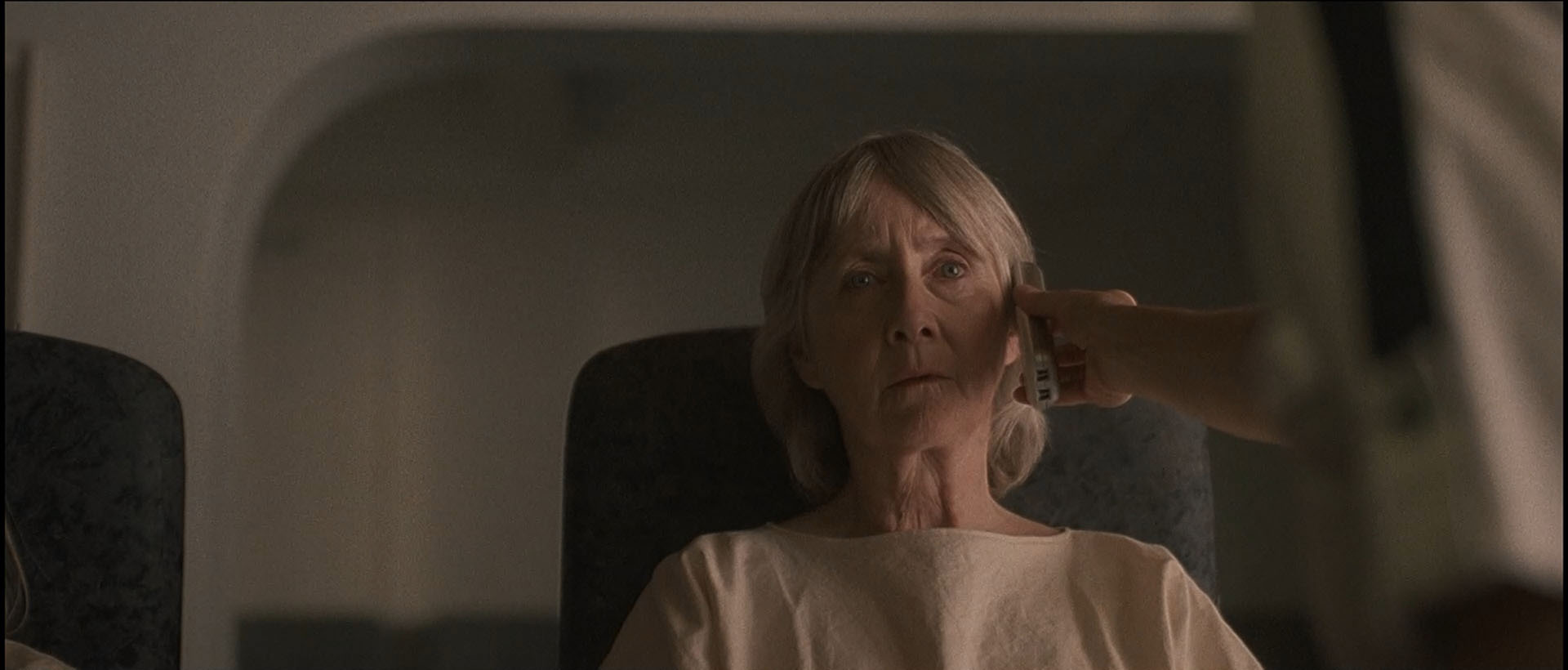 eerie images, such as a specter's fingers grasping underneath the hotel room door.
eerie images, such as a specter's fingers grasping underneath the hotel room door.
Despite lingering in viewers' memories for years, the original version was a very slippery title to find on home video; the BFI issued it in 2001 as a pricey release on DVD that quickly began commanding an insane amount of money online. In early 2012 it returned as an inclusion in the M.R. James Australian set from Shock as well as a standalone disc, both paired up with the 2010 version. A later 2012 special edition from the BFI on DVD improved in terms of both extras and image quality. The original version is, relatively speaking, presented in its most pristine form here courtesy of a new transfer from the BBC vaults, with additional cleanup over the Aussie one and, more significantly, a higher bit rate consistently maxing out well over 8.0 compared to the constant 6.5 of the Aussie. It's also worth noting that the original audio recording has always been a bit on the rough side, with some dialogue sounding a bit muffled and dull by today's standards. The HD-shot newer version was poorly compressed on the Aussie one but looks miles better here, with the sometimes gray and smoky backgrounds finally looking clean and natural without any nasty digital blockiness.
The BFI special edition marked the first release in their set of BBC ghost stories on DVD (most them "Ghost Stories for Christmas," of course), with a five-disc set issued when all were released. All of their earlier 2001 features are ported over here: a 16-minute video intro by legendary British horror novelist Ramsey Campbell (who does a good job of laying out his views on James and his fiction), Campbell doing a 27-minute reading of his own James-style ghost story "The Guide" (about a man stumbling upon a guidebook penned by the great writer himself), and Neil Brand's audio reading of the original short story, running 42 minutes. New to this set is a brief audio discussion of the film with Miller and Christopher Frayling (again mostly James-centric and originally shot but not used for a 2012 BBC profile on Miller), while the substantial liner notes booklet includes a Mark Fisher essay entitled "Old Haunts: The Landscapes of M.R. James" (a good primer analyzing the basic themes of James' fiction as well as the different approaches of the two filmed versions of this story), Reggie Oliver's James bio and a piece about some of the influences on the story (including the symbolic nature of whistling) and additional comparison notes about the two versions, and Miller, Hordern, and Hurt bios by David Thompson, Gosta Johansson, and Sonia Mullett.
Three years after the original version of Whistle and I'll Come to You, the M.R. James TV train really took off thanks in no small part to director Lawrence Gordon Clark, who took on five adaptations of the spook story legend's tales for the BBC's A Ghost Story for Christmas in the '70s and then rounded out the series with additional adaptations of other writers like Charles Dickens, Clive Exton, and John Bowen. He also directed a flawed by interesting version 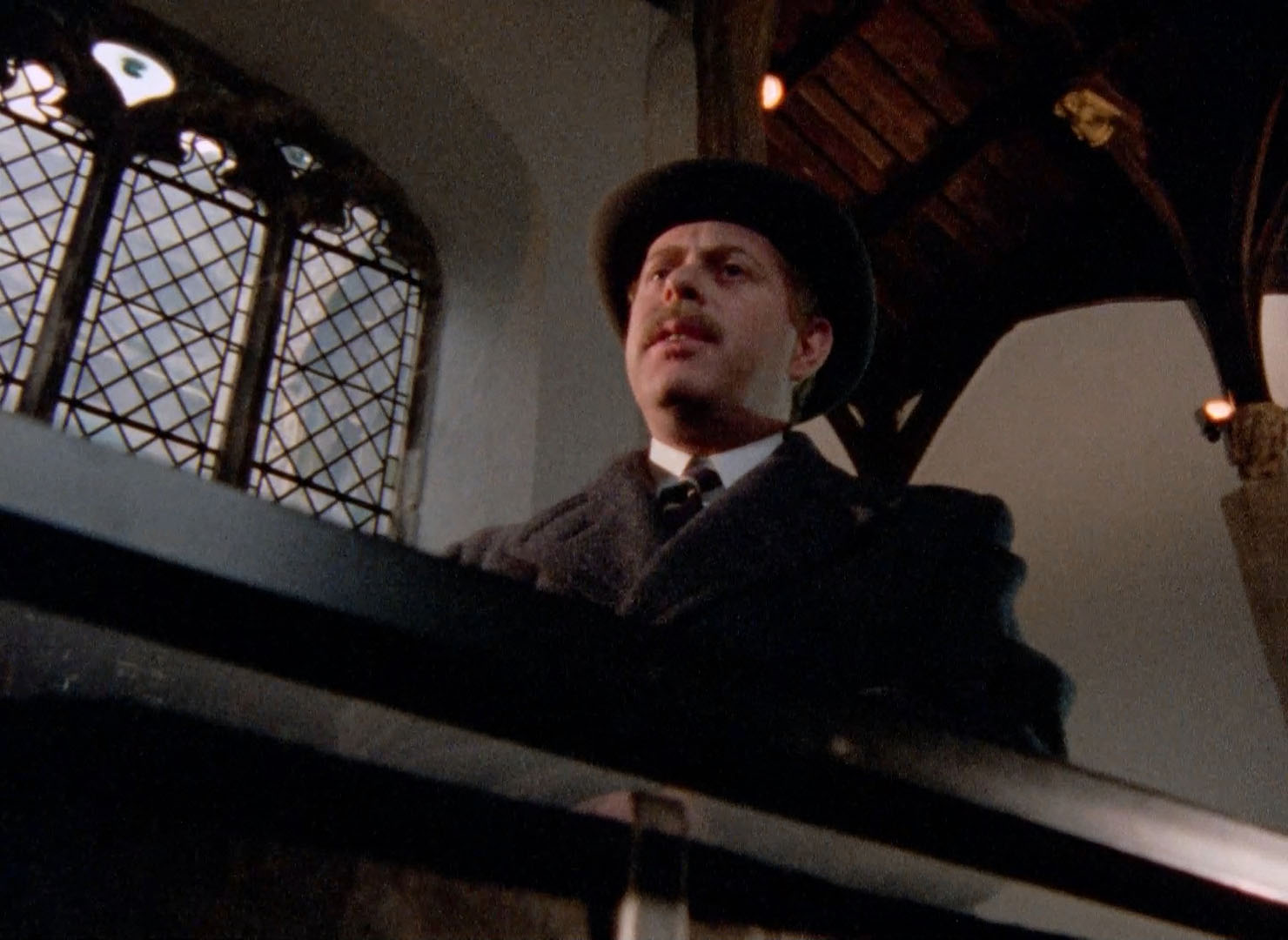 of James' Casting the Runes in 1979 for ITV, which sort of plays like an unofficial cousin to these more famous outings.
of James' Casting the Runes in 1979 for ITV, which sort of plays like an unofficial cousin to these more famous outings.
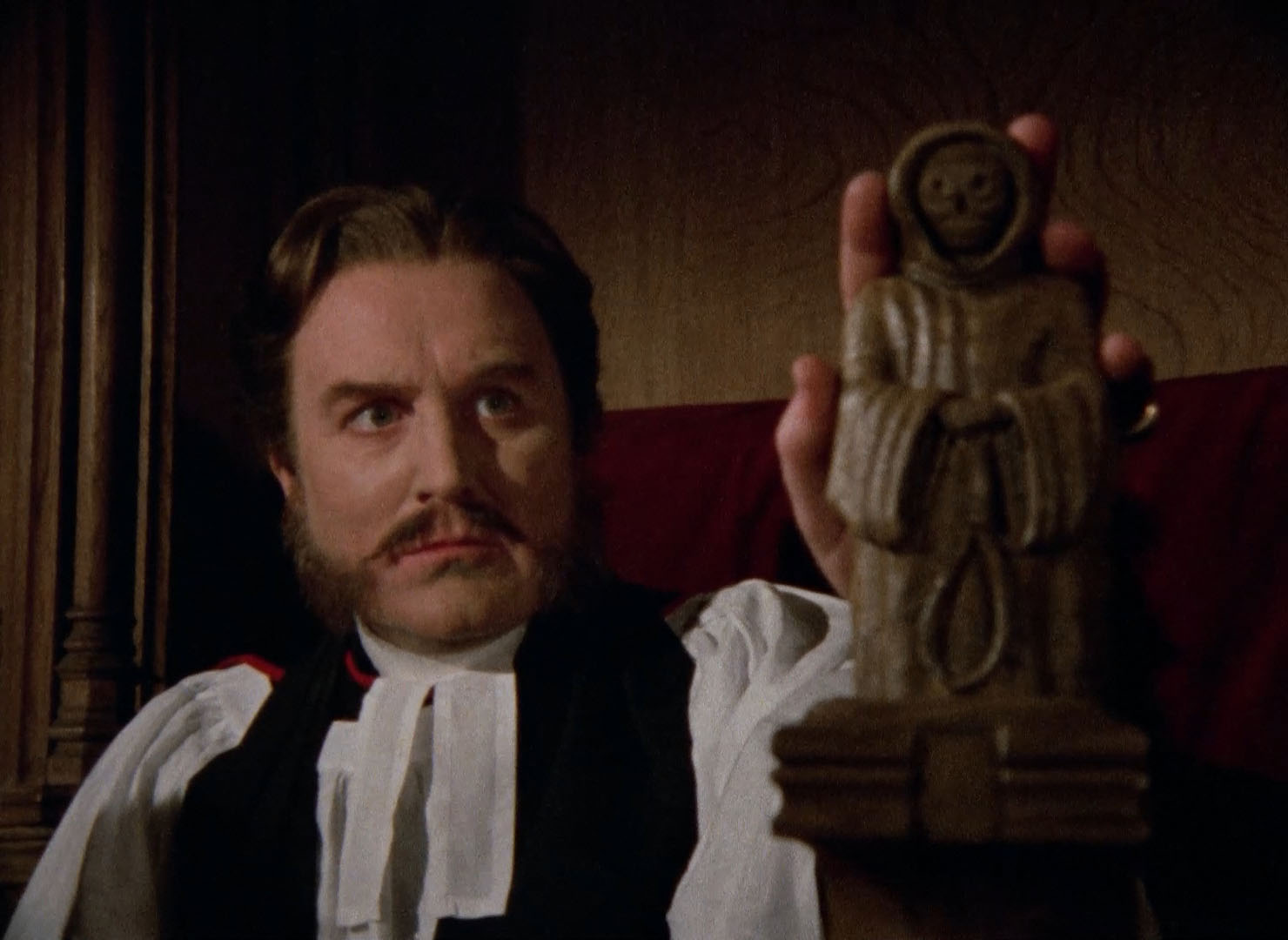 The first of his adaptations to be aired was The Stalls of Barchester, a low-key but occasionally very scary mood piece about a bespectacled scholar named Dr. Black (Swift) whose seemingly mundane assignment of sorting through the assets of the Barchester Cathedral library takes an eerie turn when he comes across the papers of the late Archdeacon (Hardy), who plotted to gain his position through murder. However, he soon comes to discover something truly horrific about the wooden choir stalls in the church, which are tied to a famous local tree and a sinister local legend.
The first of his adaptations to be aired was The Stalls of Barchester, a low-key but occasionally very scary mood piece about a bespectacled scholar named Dr. Black (Swift) whose seemingly mundane assignment of sorting through the assets of the Barchester Cathedral library takes an eerie turn when he comes across the papers of the late Archdeacon (Hardy), who plotted to gain his position through murder. However, he soon comes to discover something truly horrific about the wooden choir stalls in the church, which are tied to a famous local tree and a sinister local legend.
This one finds the James/Christmas formula already honed to perfection: a doubting protagonist to carry the viewer into the story, a tale of hidden secrets and malfeasance among the previous generation, a slow and steady opening act to build up atmosphere, and a blood-freezing finale to send viewers off to a sleepless night. Few have pegged this as their favorite of the cycle, but it's an excellent start and should hook in anyone looking for a good shiver or two. For some reason this was withheld from home video until its early 2012 Australian release, which looks much better here than the dupey copies from occasional broadcasts over the years. Like its '70s successors, this was shot on 16mm and has a somewhat rough and strangely otherworldly visual texture; it's a far cry from the glossy HD shooting you see now, but that's a permanent part of its charm. The BFI version released later in 2012 marks its first UK video release in any format, and the transfer looks very similar element-wise (including the dupier main titles, which have always looked pretty cruddy due to optical printing) but features a significantly higher (and variable) bit rate; the more careful compression results in more stable blacks and slightly more consistent flesh tones. Just bear in mind this will never look like a million bucks.
The following year saw what many regard as the high point of the series, A Warning to the Curious, which features an unforgettable 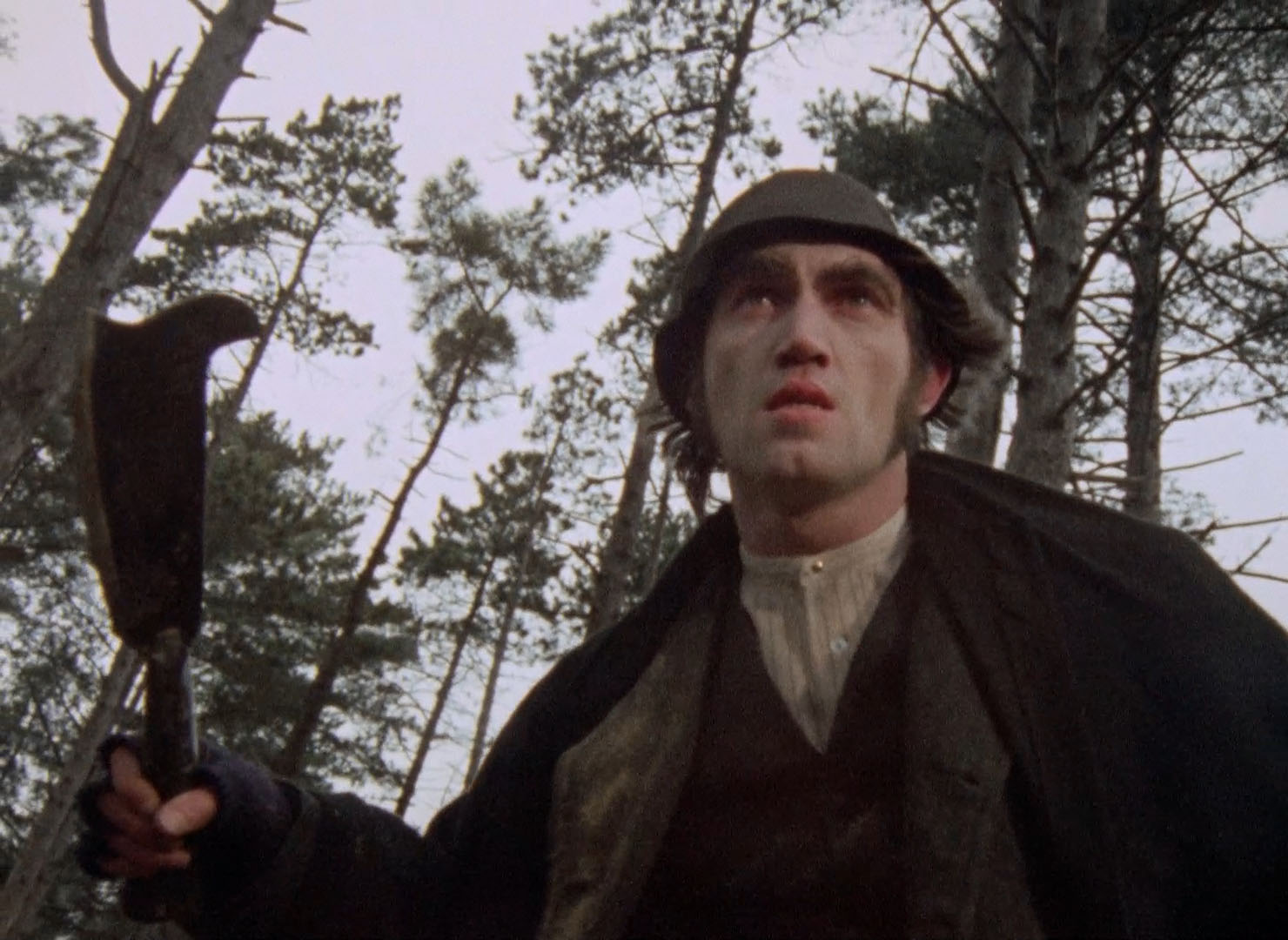 opening in which a man digging into a hill in the Norfolk countryside is stopped by a creepy local who keeps insisting, "No digging."
opening in which a man digging into a hill in the Norfolk countryside is stopped by a creepy local who keeps insisting, "No digging." 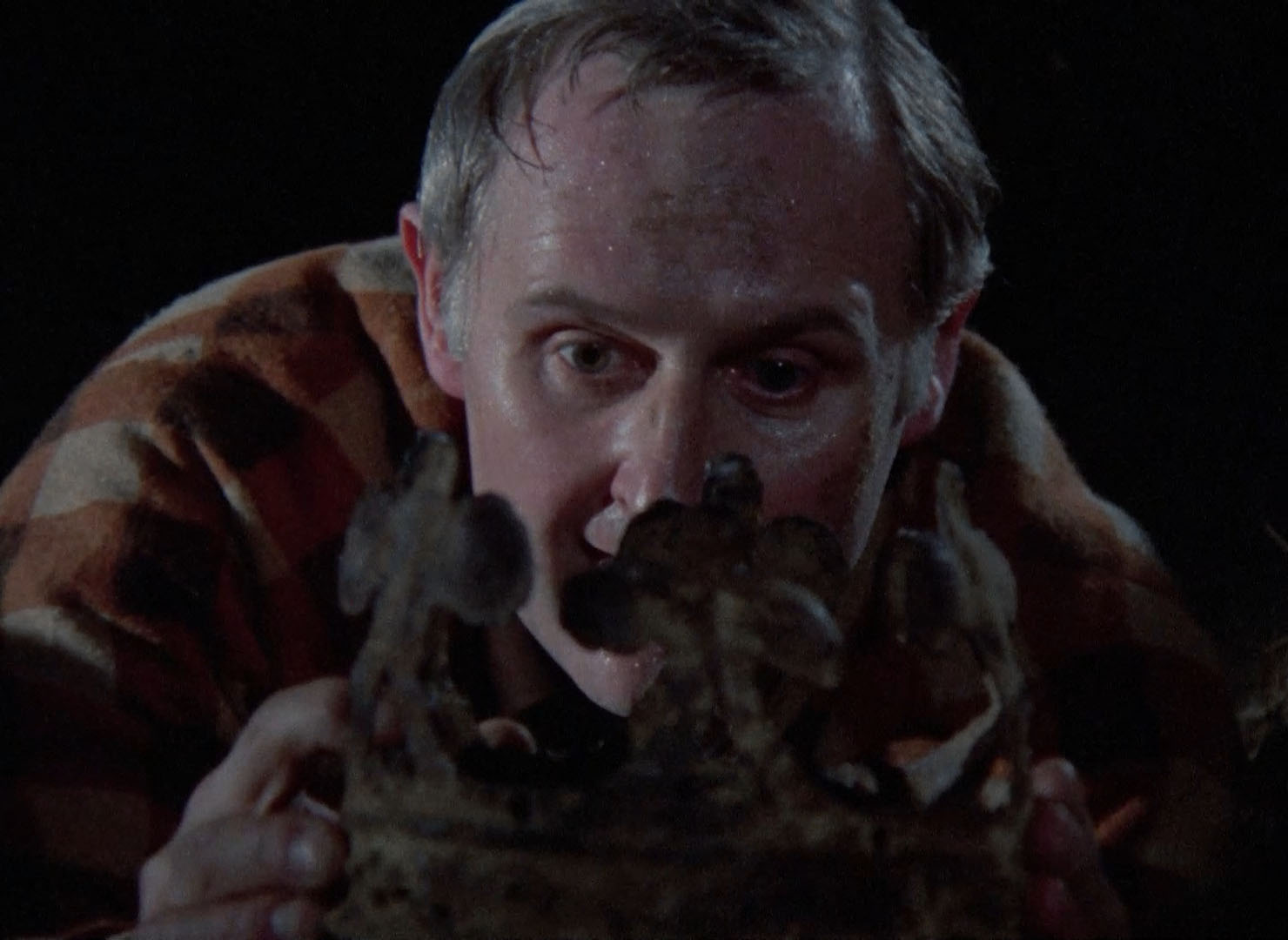 When the interloper ignores him, he gets a very nasty surprise right in the cranium. We then charge into the main story of Paxon (Vaughan), whose hobby of English archaeology and amateur treasure hunting has brought him to the coastline of Seaburgh. There he meets Dr. Black (Swift again, and yes, he's the same character) and reveals that he intends to find the last of three crowns of East Anglia which kept the British Isles safe from invasion. The other two crowns have been irretrievably lost, but this final one could be the key to fame and fortune -- despite the fact that the last man who came close to finding it twelve years ago (as we saw in the opening) met a very ugly end. When he actually does find the crown, he gets something else in the bargain and realizes it doesn't intend to leave him alone.
When the interloper ignores him, he gets a very nasty surprise right in the cranium. We then charge into the main story of Paxon (Vaughan), whose hobby of English archaeology and amateur treasure hunting has brought him to the coastline of Seaburgh. There he meets Dr. Black (Swift again, and yes, he's the same character) and reveals that he intends to find the last of three crowns of East Anglia which kept the British Isles safe from invasion. The other two crowns have been irretrievably lost, but this final one could be the key to fame and fortune -- despite the fact that the last man who came close to finding it twelve years ago (as we saw in the opening) met a very ugly end. When he actually does find the crown, he gets something else in the bargain and realizes it doesn't intend to leave him alone.
Intensely creepy stuff from start to finish, this is a bit more gruesome than expected for the series (including a bit of gore at the end), though it's actually milder than the grotesque deaths in the original short story. Interestingly, this was the only M.R. James title of the "Ghost Story" cycle to get a 2001 BFI DVD release, and that one also went out of circulation very quickly. This is easily the grainiest entry of them all, which appears to be an intentional stylistic choice; the combination of bright green trees, gold sand, and that hazy cinematic sheen creates an ambiance that suits the story perfectly. The Australian transfer appears to be from the same source, which looks a bit dated and mushy now.
In a pleasant surprise, the BFI 2012 DVD release of Warning (which pairs this with Barchester, just like the Shock one) was a completely fresh transfer and markedly different from any seen before. Details are significantly more defined, colors are more accurate and stable, and the film grain has a much tighter, more natural look here. The minor film damage is also different, interestingly enough; there's less speckling and general debris during the opening credits, for example, but you'll notice a few scratches and scuffs here in different places compared to the older transfer. On top of that, the BFI release finally includes some very welcome special features for these important titles. Clark appears for video introductions to both films, running 10 and 12 minutes respectively, complete with prominent spoiler warnings. He talks about how he got involved with getting the series off the ground, his personal affinity for James, and his interpretations of the themes and the common traits of the stories' protagonists, and it's nice to hear him preserved for posterity about some of his most famous works. On top of that you get two episodes of the 2000 series Ghost Stories for Christmas with Christopher Lee, in which the horror legend appears in a yuletide drawing room to read and act out the stories for an appreciate audience (complete with moody POV shots and other cutaways to enhance the experience). Both are presented in anamorphic widescreen (1.78:1) and look excellent, given their more recent vintage. The liner notes booklet begins with a solid Jonathan Rigby essay, "Traces of Uneasiness: Lawrence Gordon Clark and The Stalls of Barchester," which covers the early days of the James adaptations and lays the groundwork for Clark's entry into the productions. Adam Easterbrook tackles "A Warning to the Curious" by examining both the locations and the social climate of Britain at the time, painting a vivid portrait of TV and horror attitudes in 1972. The Reggie Oliver bio for James from the "Whistle" disc is carried over here, while Simon Farquhar's bio for Clark is accompanied by additional ones for Hardy (by Frances Donaldson), Swift (by Lisa Kerrigan), and Vaughan (by Kathleen Luckey), plus additional Rigby notes about the two Lee readings. Curl up on a chilly night, turn out the lights, and enjoy.
By 1973, 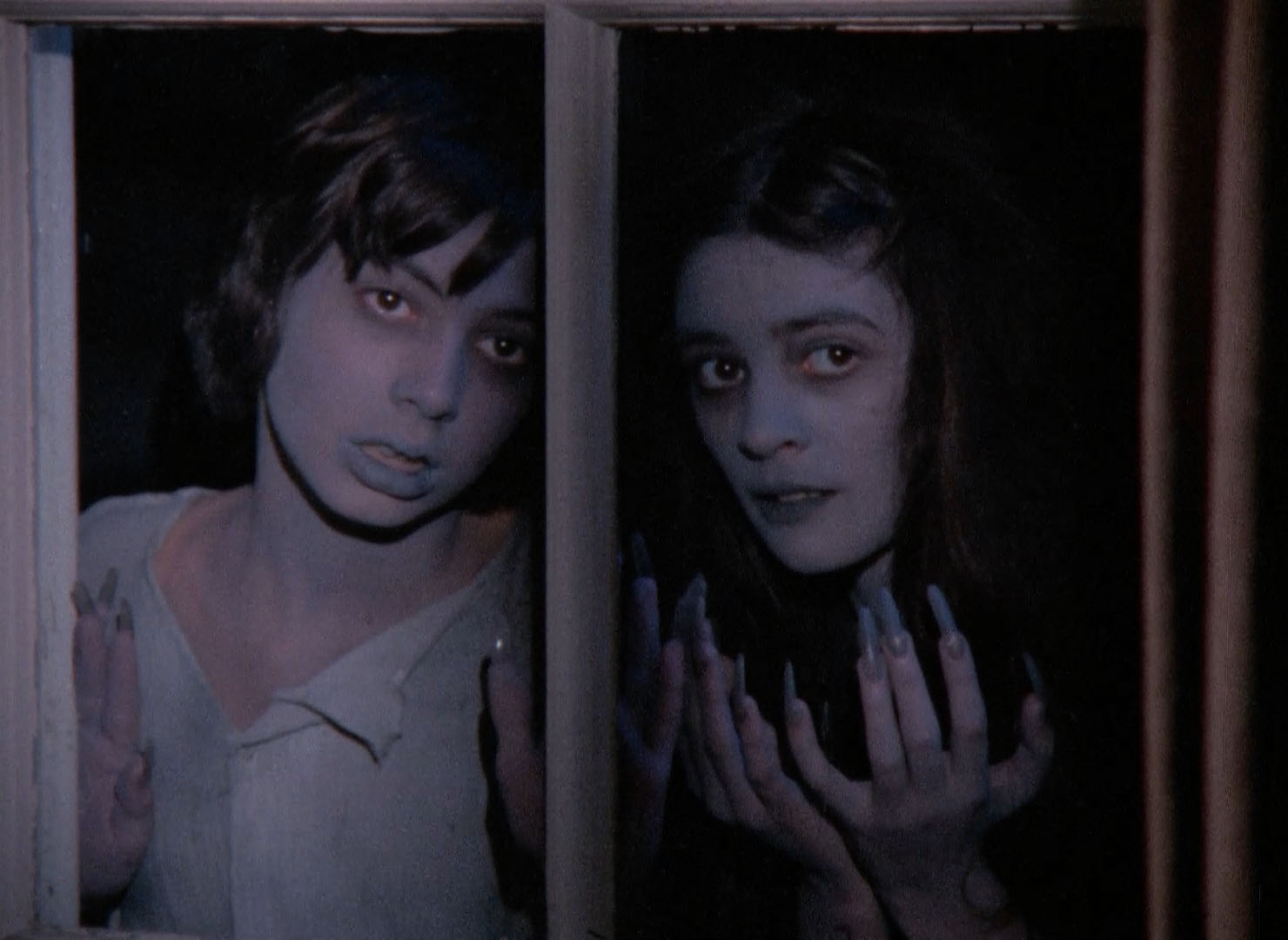 the annual Christmas ghost story tradition was firmly entrenched. The low-budget yearly broadcasts proved to be the perfect recipe for elegant chills in the dead of winter, with the famous ghost story's works turned into the modern equivalent of campfire
the annual Christmas ghost story tradition was firmly entrenched. The low-budget yearly broadcasts proved to be the perfect recipe for elegant chills in the dead of winter, with the famous ghost story's works turned into the modern equivalent of campfire 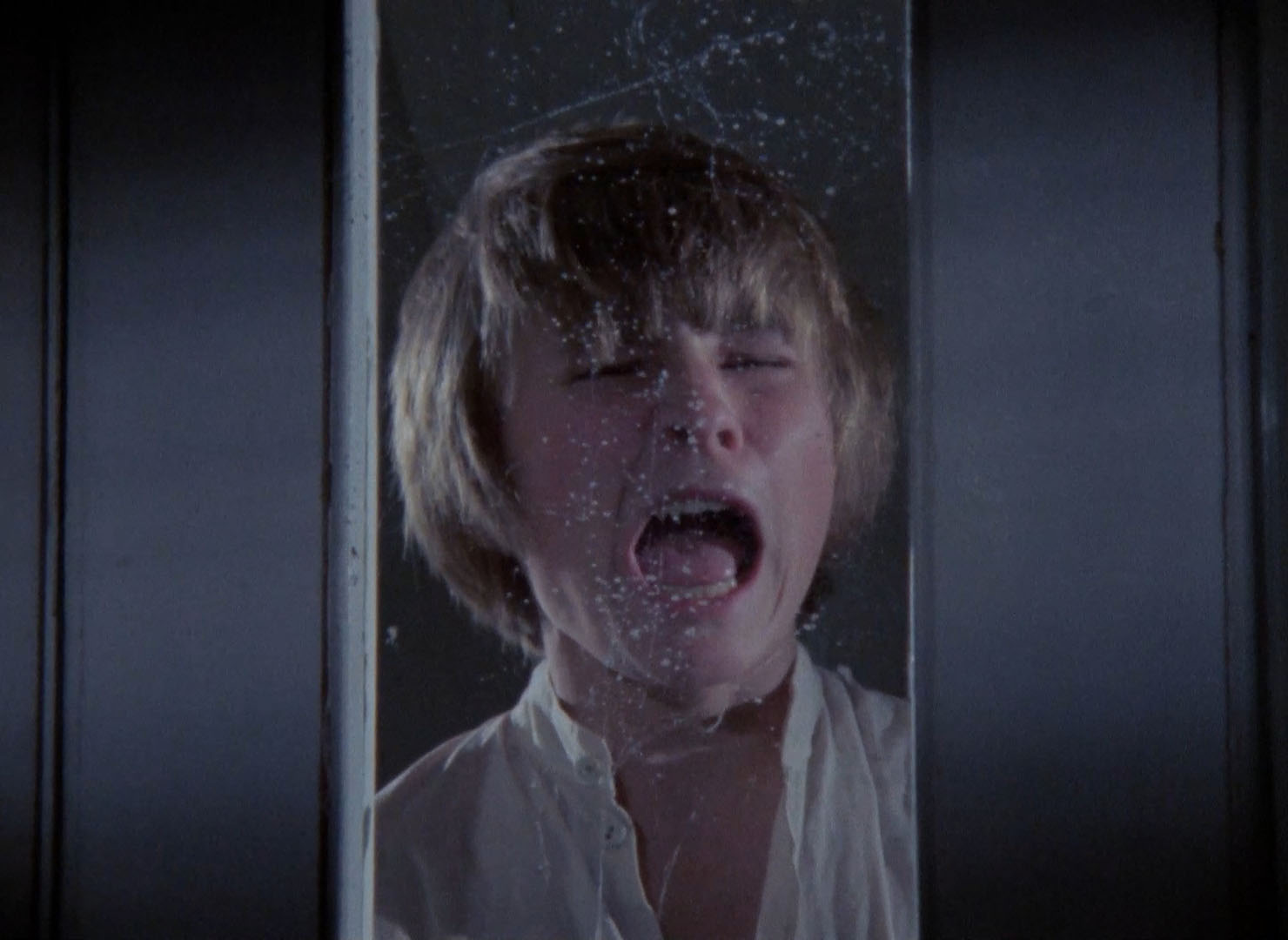 tales set in remote English manors and long-buried dens of supernatural malevolence. The third official film in the series, Lost Hearts, is in many ways the creepiest of them all. The story involves a young orphan named Stephen (The Tomorrow People's Gipps-Kent) who goes to stay with his mysterious and very odd Uncle Abney (Gorgo's O'Conor), a suspiciously friendly alchemist who has an intense fascination with keeping track of the boy's age. Stephen hears stories about two children, a gypsy boy and a young girl, who died on the property years before, and one night the two of them -- complete with blue skin and long, sharp fingernails -- begin prowling the house and lurking in his room, accompanied by off-kilter hurdy gurdy music. Oh, and their hearts have been ripped from their chests.
tales set in remote English manors and long-buried dens of supernatural malevolence. The third official film in the series, Lost Hearts, is in many ways the creepiest of them all. The story involves a young orphan named Stephen (The Tomorrow People's Gipps-Kent) who goes to stay with his mysterious and very odd Uncle Abney (Gorgo's O'Conor), a suspiciously friendly alchemist who has an intense fascination with keeping track of the boy's age. Stephen hears stories about two children, a gypsy boy and a young girl, who died on the property years before, and one night the two of them -- complete with blue skin and long, sharp fingernails -- begin prowling the house and lurking in his room, accompanied by off-kilter hurdy gurdy music. Oh, and their hearts have been ripped from their chests.
An unnerving predecessor to the vampire kids in Salem's Lot with a dash of Werner Herzog-style artiness thrown in, this is one of the shortest and tightest of the yuletide ghost stories, and it's structured a bit differently as the real horror moments lie in the middle of the story rather than the end (which closes on an ironic and strangely whimsical note instead). It's not an all-out terror fest, of course, but the sight of those two undead kids smiling as they bob up and down the hallways is not easily forgotten. Inexplicably absent from home video for decades, this made its debut first in Australia as part of an M.R. James boxed set and shortly after from the BFI in a special edition, with both versions attaching it to the same two other BBC productions. The BFI DVD looked okay for what it was; the Australian one used the same source but, as was the case with all of the BBC vs. Shock releases, the UK one boasts more careful compression and gives the films a little more breathing room. The all-important blue hues of the night scenes look especially eerie here, and apart from a little print damage that's been printed in since this was broadcast, all seems to be well here.
The BFI Blu-ray edition brings together these five titles all in HD, and the remastering of the '70s titles is quite astounding given how we've been watching them for decades. The uptick in detail is remarkable, and film grain is fine and much better realized with more defined and impressive color as well. TV historian Jon Dear provides new commentaries for Whistle and I’ll Come to You ('68) and A Warning to the Curious, while Kim Newman and Sean Hogan tackle The Stalls of Barchester and Lost Hearts. Between them you get pretty much anything you could want to know about M.R. James, the adjustments to the source material, Clark's TV tenure and work at the BBC, and trivia about scant cast members who wander through. Ported over here are the Clark intros, the two Ramsey Campbell pieces, Neil Brand's reading, and the Jonathan Miller and Christopher Frayling interview, plus the hour-long Ghost Stories For Christmas with Christopher Lee featuring The Stalls of Barchester and A Warning to the Curious.





 BBC began a '70s tradition of commemorating each Christmas with a spooky English ghost story for television, viewers had already gotten a taste of masterful gh
BBC began a '70s tradition of commemorating each Christmas with a spooky English ghost story for television, viewers had already gotten a taste of masterful gh ost story author M.R. James courtesy of one of the most eerie, memorable chillers made for the small screen courtesy of Whistle and I'll Come to You (adapted from the story "Oh, Whistle, and I'll Come to You, My Lad"). The most famous episode of the TV series Omnibus, it stars the great Michael Hordern (Theatre of Blood) as self-impressed Professor Parkins, who heads off to a Norfolk beach for some R&R and has no problem using his imposing deductive skills to dismiss any suggestion of the uncanny. One day he comes across an ancient whistle buried in the sand while researching a Templar Knights cemetery and decides to test it out... but afterwards he's plagued by the feeling that something is following him. And it isn't very nice.
ost story author M.R. James courtesy of one of the most eerie, memorable chillers made for the small screen courtesy of Whistle and I'll Come to You (adapted from the story "Oh, Whistle, and I'll Come to You, My Lad"). The most famous episode of the TV series Omnibus, it stars the great Michael Hordern (Theatre of Blood) as self-impressed Professor Parkins, who heads off to a Norfolk beach for some R&R and has no problem using his imposing deductive skills to dismiss any suggestion of the uncanny. One day he comes across an ancient whistle buried in the sand while researching a Templar Knights cemetery and decides to test it out... but afterwards he's plagued by the feeling that something is following him. And it isn't very nice.  some extra character baggage and makes a crucial change to the professor's fate. That said, there are a few arrestingly
some extra character baggage and makes a crucial change to the professor's fate. That said, there are a few arrestingly  eerie images, such as a specter's fingers grasping underneath the hotel room door.
eerie images, such as a specter's fingers grasping underneath the hotel room door. of James' Casting the Runes in 1979 for ITV, which sort of plays like an unofficial cousin to these more famous outings.
of James' Casting the Runes in 1979 for ITV, which sort of plays like an unofficial cousin to these more famous outings.  The first of his adaptations to be aired was The Stalls of Barchester, a low-key but occasionally very scary mood piece about a bespectacled scholar named Dr. Black (Swift) whose seemingly mundane assignment of sorting through the assets of the Barchester Cathedral library takes an eerie turn when he comes across the papers of the late Archdeacon (Hardy), who plotted to gain his position through murder. However, he soon comes to discover something truly horrific about the wooden choir stalls in the church, which are tied to a famous local tree and a sinister local legend.
The first of his adaptations to be aired was The Stalls of Barchester, a low-key but occasionally very scary mood piece about a bespectacled scholar named Dr. Black (Swift) whose seemingly mundane assignment of sorting through the assets of the Barchester Cathedral library takes an eerie turn when he comes across the papers of the late Archdeacon (Hardy), who plotted to gain his position through murder. However, he soon comes to discover something truly horrific about the wooden choir stalls in the church, which are tied to a famous local tree and a sinister local legend.  opening in which a man digging into a hill in the Norfolk countryside is stopped by a creepy local who keeps insisting, "No digging."
opening in which a man digging into a hill in the Norfolk countryside is stopped by a creepy local who keeps insisting, "No digging."  When the interloper ignores him, he gets a very nasty surprise right in the cranium. We then charge into the main story of Paxon (Vaughan), whose hobby of English archaeology and amateur treasure hunting has brought him to the coastline of Seaburgh. There he meets Dr. Black (Swift again, and yes, he's the same character) and reveals that he intends to find the last of three crowns of East Anglia which kept the British Isles safe from invasion. The other two crowns have been irretrievably lost, but this final one could be the key to fame and fortune -- despite the fact that the last man who came close to finding it twelve years ago (as we saw in the opening) met a very ugly end. When he actually does find the crown, he gets something else in the bargain and realizes it doesn't intend to leave him alone.
When the interloper ignores him, he gets a very nasty surprise right in the cranium. We then charge into the main story of Paxon (Vaughan), whose hobby of English archaeology and amateur treasure hunting has brought him to the coastline of Seaburgh. There he meets Dr. Black (Swift again, and yes, he's the same character) and reveals that he intends to find the last of three crowns of East Anglia which kept the British Isles safe from invasion. The other two crowns have been irretrievably lost, but this final one could be the key to fame and fortune -- despite the fact that the last man who came close to finding it twelve years ago (as we saw in the opening) met a very ugly end. When he actually does find the crown, he gets something else in the bargain and realizes it doesn't intend to leave him alone.  the annual Christmas ghost story tradition was firmly entrenched. The low-budget yearly broadcasts proved to be the perfect recipe for elegant chills in the dead of winter, with the famous ghost story's works turned into the modern equivalent of campfire
the annual Christmas ghost story tradition was firmly entrenched. The low-budget yearly broadcasts proved to be the perfect recipe for elegant chills in the dead of winter, with the famous ghost story's works turned into the modern equivalent of campfire  tales set in remote English manors and long-buried dens of supernatural malevolence. The third official film in the series, Lost Hearts, is in many ways the creepiest of them all. The story involves a young orphan named Stephen (The Tomorrow People's Gipps-Kent) who goes to stay with his mysterious and very odd Uncle Abney (Gorgo's O'Conor), a suspiciously friendly alchemist who has an intense fascination with keeping track of the boy's age. Stephen hears stories about two children, a gypsy boy and a young girl, who died on the property years before, and one night the two of them -- complete with blue skin and long, sharp fingernails -- begin prowling the house and lurking in his room, accompanied by off-kilter hurdy gurdy music. Oh, and their hearts have been ripped from their chests.
tales set in remote English manors and long-buried dens of supernatural malevolence. The third official film in the series, Lost Hearts, is in many ways the creepiest of them all. The story involves a young orphan named Stephen (The Tomorrow People's Gipps-Kent) who goes to stay with his mysterious and very odd Uncle Abney (Gorgo's O'Conor), a suspiciously friendly alchemist who has an intense fascination with keeping track of the boy's age. Stephen hears stories about two children, a gypsy boy and a young girl, who died on the property years before, and one night the two of them -- complete with blue skin and long, sharp fingernails -- begin prowling the house and lurking in his room, accompanied by off-kilter hurdy gurdy music. Oh, and their hearts have been ripped from their chests. ![]()